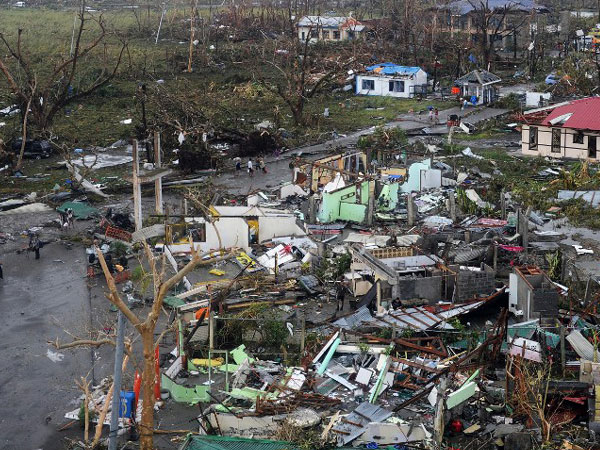Yolanda-hit Eastern Visayas to get only P6.9B infra in 2014—DPWH report

TRAIL OF DESTRUCTION A general shot shows houses destroyed by the strong winds caused by Typhoon Yolanda in Tacloban City. AFP
MANILA, Philippines—Eastern Visayas, which was ravaged by supertyphoon “Yolanda” in November 2013, will receive only P6.91 billion for infrastructure projects this year, according to a Department of Public Works and Highways (DPWH) report posted on the agency’s website.
On the other hand, the National Capital Region (NCR) will get nearly P24 billion, the biggest slice of the capital outlay, followed by Southern Tagalog and Western Visayas, both with P12.6 billion each; Central Luzon, P11.95 billion; Northern Mindanao, P11.02 billion, and Bicol, P9.92 billion.
Next on the list are Mimaropa with P8.03 billion; Central Visayas, P7.91 billion; Davao region, P7.89 billion; Western Mindanao, P7.34 billion; Cordillera Administrative Region, P6.87 billion; Cagayan Valley, P6.67 billion; Ilocos region, P6.36 billion; Caraga, P5.77 billion, and Soccskargen, P5.55 billion.
Not on the DPWH list is the Autonomous Region in Muslim Mindanao (ARMM) which last year received P30.73 billion, the most for infrastructure projects nationwide then.
The DPWH Public Information Division (PID) said this year the DPWH-ARMM would have a “separate funding.” It did not say how much.
The ARMM’s budget for public works comes from the national government’s Stimulus Development Plan (SDP) for the region, one of the poorest and most underdeveloped areas in the country, noted PID chief Elizabeth Pilorin.
The DPWH, which Malacañang has designated as the lead agency in implementing the SDP, has created a task force to closely monitor the program where projects promoting basic services, infrastructure and livelihood development would be prioritized for funding.
This year, the government is setting aside a total of P190.93 billion for infrastructure projects nationwide. This is P46.59 billion higher than last year’s P144.34 billion.
The 2014 allocations include P129.41 billion for the rehabilitation of the remaining 15,872 kilometers of gravel and unpaved arterial roads all over the country, which is P18.5 billion higher than last year’s budget of P110.9 billion.
The national road network, described by Public Works Secretary Rogelio Singson as the “most important infrastructure asset of the government,” had budget allocations of P68.04 in 2011 and P78.1 billion in 2012.
Singson had said the DPWH would “prioritize rehabilitation over preventive maintenance” in the preservation of the country’s road network in the last two years of the Aquino administration.
The road network would be worth at least P1.2 trillion, he pointed out.
Singson also said the DPWH would “continue improving the smoothness of the national highways through improved construction processes, tighter supervision and quality assurance during the construction stage.”
The DPWH’s other priorities in 2015 and 2016 include the following: Pavement of the remaining rough roads nationwide; replacement of all timber and bailey bridges with concrete or steel structures; construction of better drainage along primary roads to ensure longer life span for the thoroughfares, and improved flood control and other climate change adaptation measures.
To achieve its national road network-related goals, the DPWH is “adopting the following strategic measures: Good governance reforms; anticorruption initiatives; better quality and safer national road programs; public-private partnerships, and effective flood control programs,” he added.
In the NCR, the DPWH is pushing, among other projects, the much-delayed P3.74-billion major rehabilitation of Efipanio de los Santos Avenue, or Edsa, after the P230-million concrete reblocking of around 80,000 square meters of pavement on the busiest thoroughfare in the metropolis.
“An asphalt overlay is the next best thing to the piecemeal repairs on Edsa,” said DPWH-NCR Director Reynaldo Tagudando.
Singson earlier said that transforming Edsa into a road as “smooth” as the North Luzon and South Luzon Expressways could be achieved in one or two years.
He pointed out that the highway’s deterioration over the decades showed that “our road standards have really gone down… we are setting up for roads full of potholes.”
Edsa, which was completed in 1954 and previously named Highway 54, had practically been neglected by previous administrations, he said.
Other planned infrastructure projects in Metro Manila include the construction of the P3.03-billion Edsa-Taft Avenue flyover; Phase 1 of the P1.7-billion Liwasang Bonifacio-Sta. Monica bridge and the P700-million Gov. Forbes-España vehicle underpass, both in Manila; the P793-million Sen. Gil Puyat-Makati Avenue-Paseo de Roxas vehicle underpass in Makati City; and the P1.5-billion widening of the C-5 Bagong Ilog flyover in Pasig City, among others.














